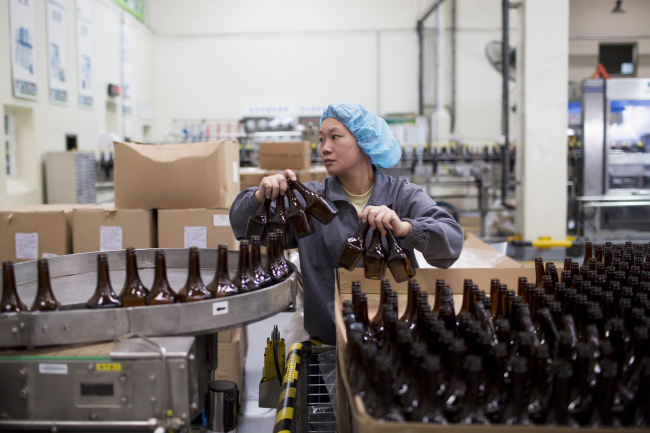Chinese manufacturing gauges pointed to weakness in the world’s second-biggest economy that could prompt the Communist Party leadership to roll out additional support measures.
A Purchasing Managers’ Index fell to 48 in March, the lowest reading since July, from 48.5 in February, HSBC Holdings Plc and Markit Economics said Tuesday. A separate PMI from the government, with a larger sample size, was at 50.3 from 50.2 the previous month.
The reports underscore what Premier Li Keqiang last week called “difficulties and risks” as he tries to control surging debt, default dangers and pollution that threatens to stoke public discontent. Li said the nation has policies in reserve to support economic growth after the cabinet said it would accelerate construction spending.
 |
An employee loads bottles onto a conveyor at the Nestle Dongguan Ltd. factory in Dongguan, Guangdongprovince, China. (Bloomberg) |
“We expect Beijing to fine-tune policy sooner rather than later to stabilize growth,” said Qu Hongbin, chief China economist at HSBC in Hong Kong. He added that the pace of first-quarter growth is likely to have fallen below the nation’s full-year target of 7.5 percent.
The MSCI Asia Pacific Index of stocks fell 0.1 percent as of 11:36 a.m. in Tokyo. In Japan, an increase in a sales tax from Tuesday is projected to cut gross domestic product this quarter, indicating that a gain in sentiment among large manufacturers may be short-lived. The Tankan index was at 17 in March, the highest level since 2007, a report showed.
Li said last week he was confident China will keep economic growth in a “reasonable range.” The nation will gradually introduce “powerful” measures, including speeding up construction of key investment projects and building railways, roads and irrigation infrastructure, he said.
Government officials will monitor power output, coal useage and crude-oil processing, after the National Development and Reform Commission said March 26 that it saw signs of economic improvement last month in those data.
The median estimate of analysts for first-quarter growth dropped to 7.4 percent in March from 7.6 percent in February, according to Bloomberg News surveys. For the full year, the median forecast slid to 7.4 percent, which would be the weakest annual pace since 1990.
Deutsche Bank AG cut its projection to 7.8 percent from 8.6 percent, according to a March 28 report.
Debt dangers have been marked by events this year that include China’s first onshore bond default, the collapse of a real-estate developer and the bailout of a 3 billion-yuan ($483 million) China Credit Trust Co. product that lent money to a failed coal miner. (Bloomberg)








